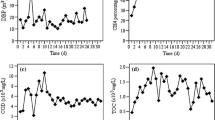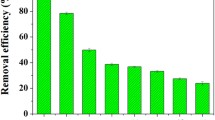Abstract
Swine wastewater is one of the most serious pollution sources, and it has attracted a great public concern in China. Anaerobic digestion technology is extensively used in swine wastewater treatment. However, the anaerobic digestion effluents are difficult to meet the discharge standard. The results from batch experiments showed that plenty of refractory organic matter remained in the effluents after mesophilic anaerobic digestion for 30 days. The effluent total COD (tCOD) and soluble COD (sCOD) were 483 and 324 mg/L, respectively, with the sCOD/tCOD ratio of 0.671. Fluorescence excitation–emission matrix (EEM) coupled with parallel factor analysis (PARAFAC) revealed that the dissolved organic matter in the effluents was tryptophan-like substance, humic acid substance, and fulvic acid substance. Based on the appearance time during anaerobic digestion, tryptophan-like substance and humic acid substance were inferred to originate from the raw swine wastewater, and the fulvic acid substance was inferred to be formed in the anaerobic digestion. This work has revealed the source of residual organic matter in anaerobic digestion of swine wastewater and has provided some valuable information for the post-treatment.





Similar content being viewed by others
References
APHA (2005) Standard methods for the examination of water and wastewater. A.P.H. Association, Washington
Bergland WH, Dinamarca C, Toradzadegan M, Nordgård ASR, Bakke I, Bakke R (2015) High rate manure supernatant digestion. Water Res 76:1–9
Boopathy R (1998) Biological treatment of swine waste using anaerobic baffled reactors. Bioresour Technol 64:1–6
Chae KJ, Jang AM, Yim SK, Kim IS (2008) The effects of digestion temperature and temperature shock on the biogas yields from the mesophilic anaerobic digestion of swine manure. Bioresour Technol 99:1–6
Chen W, Westerhoff P, Leenheer JA, Booksh K (2003) Fluorescence excitation-emission matrix regional integration to quantify spectra for dissolved organic matter. Environmental science & technology 37(24):5701–5710
Chen M, Price RM, Yamashita Y, Jaffé R (2010) Comparative study of dissolved organic matter from groundwater and surface water in the Florida coastal Everglades using multi-dimensional spectrofluorometry combined with multivariate statistics. Appl Geochem 25:872–880
Cook RL, Birdwell JE, Lattao C, Lowry M (2009) A multi-method comparison of Atchafalaya Basin surface water organic matter samples. J Environ Qual 38(2):702–711
Crawford DL, Pometto AL, Crawford RL (1983) Lignin degradation by Streptomyces viridosporus: isolation and characterization of a new polymeric lignin degradation intermediate. Appl Environ Microbiol 45:898–904
Deng LW, Zheng P, Chen ZA (2006) Anaerobic digestion and post-treatment of swine wastewater using IC–SBR process with bypass of raw wastewater. Process Biochem 41:965–969
Dong B, Jiang S (2009) Characteristics and behaviors of soluble microbial products in sequencing batch membrane bioreactors at various sludge retention times. Desalination 243(1):240–250
Goel S, Hozalski RM, Bouwer EJ (1995) Biodegradation of NOM: effect of NOM source and ozone dose. J Am Water Works Ass 87:90–105
Hambly AC, Arvin E, Pedersen LF, Pedersen PB, Seredyńska-Sobecka B, Stedmon CA (2015) Characterising organic matter in recirculating aquaculture systems with fluorescence EEM spectroscopy. Water Res 83:112–120
Hong H, Yang L, Guo W, Wang F, Yu X (2012) Characterization of dissolved organic matter under contrasting hydrologic regimes in a subtropical watershed using PARAFAC model. Biogeochemistry 109:163–174
Hu CH, YU SD, Xu ZR (2002) Effect of mixed population of pig fecal bacteria on 3-methylindole (skatole) and indole production. Chinese Journal of Animal Science 38:10–11 (Chinese)
Hunt JF, Ohno T (2007) Characterization of fresh and decomposed dissolved organic matter using excitation-emission matrix fluorescence spectroscopy and multiway analysis. J Agric Food Chem 55(6):2121–2128
Hur J, Shin J, Kang M, Cho J (2014) Tracking variations in fluorescent-dissolved organic matter in an aerobic submerged membrane bioreactor using excitation–emission matrix spectra combined with parallel factor analysis. Bioprocess Biosyst Eng 37:1487–1496
Ishii SK, Boyer TH (2012) Behavior of reoccurring PARAFAC components in fluorescent dissolved organic matter in natural and engineered systems: a critical review. Environ. Sci. Technol. 46:2006–2017
Jiang T, Schuchardt F, Li GX, Guo R, Luo YM (2013) Gaseous emission during the composting of pig feces from Chinese Ganqinfen system. Chemosphere 90(4):1545–1551
Ko JJ, Shimizu Y, Ikeda K, Kim SK, Park CH, Matsui S (2009) Biodegradation of high molecular weight lignin under sulfate reducing conditions: lignin degradability and degradation by-products. Bioresour Technol 100:1622–1627
Kunacheva C, Stuckey DC (2014) Analytical methods for soluble microbial products (SMP) and extracellular polymers (ECP) in wastewater treatment systems: a review. Water Res 61:1–18
Lakowicz JR (2006) Principles of fluorescence spectroscopy. Springer Science & Business Media, New York
Laspidou CS, Rittmann BE (2002) A unified theory for extracellular polymeric substances, soluble microbial products, and active and inert biomass. Water Res 36(11):2711–2720
Lee YH, Chung YC, Jung JY (2008) Effects of chemical and enzymatic treatments on the hydrolysis of swine wastewater. Water Sci Technol 58:1529–1534
Lee BM, Seo YS, Hur J (2015) Investigation of adsorptive fractionation of humic acid on graphene oxide using fluorescence EEM-PARAFAC. Water Res 73:242–251
Lettinga G (1995) Anaerobic digestion and wastewater treatment systems. Antonie Van Leeuwenhoek 67:3–28
Lim SJ, Park W, Kim TH, Shin IH (2012) Swine wastewater treatment using a unique sequence of ion exchange membranes and bioelectrochemical system. Bioresour Technol 118:163–169
Massé DI, Talbot G, Gilbert Y (2011) On farm biogas production: a method to reduce GHG emissions and develop more sustainable livestock operations. Anim Feed Sci Technol 166:436–445
Murphy KR, Stedmon CA, Graeber D, Bro R (2013) Fluorescence spectroscopy and multi-way techniques. PARAFAC Analytical Methods 5(23):6557–6566
Ni BJ, Rittmann BE, Fang F, Xu J, Yu HQ (2010) Long-term formation of microbial products in a sequencing batch reactor. Water Res 44(13):3787–3796
Ni BJ, Rittmann BE, Yu HQ (2011) Soluble microbial products and their implications in mixed culture biotechnology. Trends Biotechnol 29:454–463
Ohno T, He Z, Sleighter RL, Honeycutt CW, Hatcher PG (2010) Ultrahigh resolution mass spectrometry and indicator species analysis to identify marker components of soil-and plant biomass-derived organic matter fractions. Environ Sci Technol 44:8594–8600
Phong DD, Hur J (2015) Insight into photocatalytic degradation of dissolved organic matter in UVA/TiO 2 systems revealed by fluorescence EEM-PARAFAC. Water Res 87:119–126
Ramesh A, Lee DJ, Hong SG (2006) Soluble microbial products (SMP) and soluble extracellular polymeric substances (EPS) from wastewater sludge. Appl Microbiol Biotechnol 73:219–225
Rezaei R, Wang W, Wu Z, Dai Z, Wang J, Wu G (2013) Biochemical and physiological bases for utilization of dietary amino acids by young pigs. Journal of Animal Science and Biotechnology 4(1):1
Santín C, Yamashita Y, Otero XL, Alvarez MA, Jaffé R (2009) Characterizing humic substances from estuarine soils and sediments by excitation-emission matrix spectroscopy and parallel factor analysis. Biogeochemistry 96(1–3):131–147
Stams AJ (1994) Metabolic interactions between anaerobic bacteria in methanogenic environments. Antonie Van Leeuwenhoek 66:271–294
Stedmon CA, Bro R (2008) Characterizing dissolved organic matter fluorescence with parallel factor analysis: a tutorial. Limnol Oceanogr Meth 6:572–579
Stein HH, Seve B, Fuller MF, Moughan PJ, De Lange CFM (2007) Invited review: amino acid bioavailability and digestibility in pig feed ingredients: terminology and application. J Anim Sci 85(1):172–180
Sutton R, Sposito G (2005) Molecular structure in soil humic substances: the new view. Environmental Science & Technology 39(23):9009–9015
Wang YY, Qiu WF, Fan YZ, Gu JD (2002) Degradation pathways and mechanisms of substituted indoles under methanogenic condition. Chinese Journal of Applied and Environmental Biology 8:514–519 (Chinese)
Wang Z, Wu Z, Tang S (2009) Characterization of dissolved organic matter in a submerged membrane bioreactor by using three-dimensional excitation and emission matrix fluorescence spectroscopy. Water Res 43(6):1533–1540
Weiland P (2010) Biogas production: current state and perspectives. Appl Microbiol Biotechnol 85:849–860
Whang GD, Cho YM, Park H, Jang JG (2004) The removal of residual organic matter from biologically treated swine wastewater using membrane bioreactor process with powdered activated carbon. Water Sci Technol 49:451–457
Yokoyama MT, Carlson JR (1974) Dissimilation of tryptophan and related indolic compounds by ruminal microorganisms in vitro. Appl Microbiol 27:540–548
Zhang Y, Yin Y, Feng L, Zhu G, Shi Z, Liu X, Zhang Y (2011) Characterizing chromophoric dissolved organic matter in Lake Tianmuhu and its catchment basin using excitation-emission matrix fluorescence and parallel factor analysis. Water Res 45(16):5110–5122
Zhou Z, Meng F, Chae SR, Huang G, Fu W, Jia XS, Li SY, Chen GH (2012) Microbial transformation of biomacromolecules in a membrane bioreactor: implications for membrane fouling investigation. PLoS One 7:e42270
Acknowledgements
This work was financially supported by the Zhejiang Key Science and Technology Innovation Team Project Grant (No. 2013TD03).
Author information
Authors and Affiliations
Corresponding author
Additional information
Responsible editor: Philippe Garrigues
Rights and permissions
About this article
Cite this article
Zeng, Z., Zheng, P., Ding, A. et al. Source analysis of organic matter in swine wastewater after anaerobic digestion with EEM-PARAFAC. Environ Sci Pollut Res 24, 6770–6778 (2017). https://doi.org/10.1007/s11356-016-8324-3
Received:
Accepted:
Published:
Issue Date:
DOI: https://doi.org/10.1007/s11356-016-8324-3




